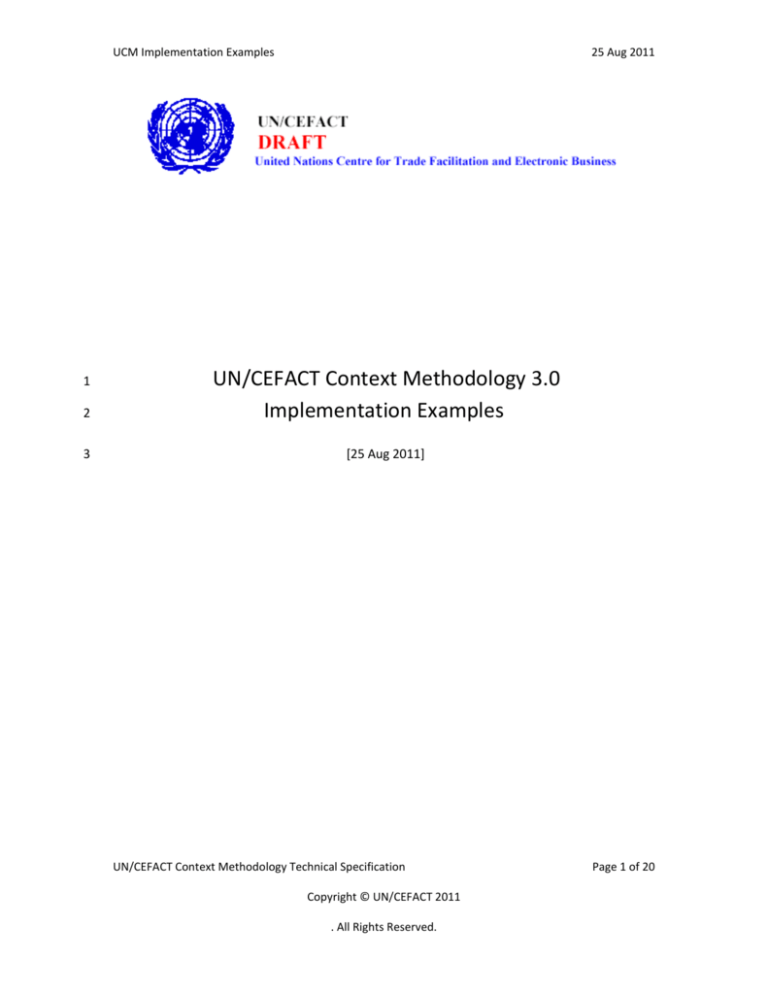
UCM Implementation Examples
25 Aug 2011
2
UN/CEFACT Context Methodology 3.0
Implementation Examples
3
[25 Aug 2011]
1
UN/CEFACT Context Methodology Technical Specification
Copyright © UN/CEFACT 2011
. All Rights Reserved.
Page 1 of 20
UCM Implementation Examples
4
Contents
5
1
6
7
GENERAL EXAMPLE OF CONTEXT EXPRESSIONS ..............................................................3
1.1
2
25 Aug 2011
Example Implementation ............................................................................................... 3
USING CCTS 2.0 WITH THE BUSINESS CONTEXT FRAMEWORK – EXAMPLE .......................5
8
2.1
Set-up ............................................................................................................................. 5
9
2.2
Contextualized Hierarchy ............................................................................................... 5
10
2.3
Definition - UnionContextualized................................................................................... 6
11
2.4
Contextualized Hierarchy Applied to CCTS BIEs............................................................. 6
12
13
14
2.4.1
2.5
2.5.1
Application of Context ............................................................................................... 7
Example using CCTS ....................................................................................................... 8
Applying a Message Context ................................................................................... 16
15
16
UN/CEFACT Context Methodology Technical Specification
Copyright © UN/CEFACT 2011
. All Rights Reserved.
Page 2 of 20
UCM Draft A60
25 Aug 2011
17
1 General Example of Context Expressions
18
19
20
1.1 Example Implementation
This example uses the context graph described in figure 1.1. It shows how different nodes may
be assigned context using the different predicates and operands.
D
B
E
C
F
A
I
H
G
J
21
22
Figure 1.1. DAG example identified by urn:un:unece:uncefact:context:draft:20091001682ba7e31f26 version 1.0
23
24
Table 1.1 shows how the context expressions in the ContextClause can be used to create a
Contextualized with the included ContextNodes.
Contextualized
Assignment
ContextClause
Assigned Context
Contextualized1
== A
A
Contextualized2
<= B
B, C, D, E, F, H, I, J
Contextualized3
<= A
A, B, C, D, E, F, G, H, I, J
Contextualized4
((< A) !! (<= H)) || (== I) B, C, D, E, F, G, I
Contextualized5
== C
C
Contextualized6
(<= H) !! (== I)
H, J
Contextualized7
(>= H) !! (== G)
A, B, H
25
Table 1.1. Assigning Context the Assignment ContextClause and the resulting Assigned Context
26
27
Table 1.2 shows how a ContextClause can be used to select all of the Contextualized that are
valid in a given context.
UN/CEFACT Context Methodology Technical Specification
Copyright © UN/CEFACT 2011
. All Rights Reserved.
Page 3 of 20
UCM Draft A60
25 Aug 2011
28
Applied
ContextClause
== A
(== A) !! (== B)
(== A) && (== B)
(== I) || (== J)
29
Processing Description
Results
Create a set of all Contextualized that have ‘A’ Contextualized1,
assigned as a ContextNode
Contextualized3,
Contextualized7
Create a set of all Contextualized that have ‘A’ Contextualized1
assigned as a ContextNode and then Exclude
all Contextualized from the set that have ‘B’
assigned as a ContextNode.
Create a set of all Contextualized that have ‘A’ Contextualized3,
assigned as a ContextNode then create a set Contextualized7
of all Contextualized that have ‘B’ assigned as
a ContextNode and then perform an
intersection of the two sets.
Create a set of all Contextualized that have ‘I’
assigned as a ContextNode then create a set
of all Contextualized that have ‘J’ assigned as
a ContextNode and then perform a union of
the two sets.
Contextualized2,
Contextualized3,
Contextualized4,
Contextualized6
Table 1.2. Results of Applying Context
30
UN/CEFACT Context Methodology Technical Specification
Copyright © UN/CEFACT 2011
. All Rights Reserved.
Page 4 of 20
UCM Draft A60
25 Aug 2011
31
2 Using CCTS 2.0 with the Business Context Framework – Example
32
33
34
35
36
37
2.1 Set-up
38
39
This example represents one, very comprehensive, method for implementing context. Other
methods may be used to implement UCM with CCTS.
40
2.2 Contextualized Hierarchy
This example identifies different types of Contextualized to meet the requirements for
Aggregate Business Information Entities (ABIEs), Association Business Information Entities
(ASBIEs), Basic Business Information Entities (BBIEs) and Business Value Domains (BVDs) as
defined in the CCTS 3.0 specification. Other types of objects also may be contextualized using
one of these types.
«interface»
Contextualized
+
+dependency
getContext() : ContextExpression 1..*
0..*
«interface»
AssignedContextualized
+
«interface»
IndependentContextualized
setAssignedContext(ContextExpression) : void
«interface»
DependentContextualized
+
calculateContext() : void
Mutually exclusive
BBIE Version
«interface»
UnionContextualized
«interface»
IntersectionContextualized
Mutually exclusive
ABIE Version
1
0..*
ASBIE Version
41
42
Figure 1.1Contextualized Hierarchy
43
44
There is a hierarchy of Contextualized. They differ in how context has been assigned to them or
calculated for them.
UN/CEFACT Context Methodology Technical Specification
Copyright © UN/CEFACT 2011
. All Rights Reserved.
Page 5 of 20
UCM Draft A60
25 Aug 2011
45
Definition - AssignedContextualized
46
47
An AssignedContextualized is an object to which a business context has been
assigned, using a UCM context expression.
48
49
50
The context that is assigned to an AssignedContextualized is sometime the same as its overall
context, but sometimes the assigned context is only one of the contexts that contribute to the
overall context.
51
Definition - IndependentContextualized
52
53
An IndependentContextualized is an object for which the overall context is
independent of the overall context of any other object.
54
55
The overall context of an IndependentContextualized cannot be changed by a change to the
overall context of some other object.
56
Definition - DependentContextualized
57
58
59
A DependentContextualized is an object for which the overall context is
calculated, and the calculation depends of the overall context of at least one
other object.
60
61
The overall context of a DependentContextualized can be changed by a change to the overall
context of an object on which it has a context dependency.
62
2.3 Definition - UnionContextualized
63
Definition – UnionContextualized
64
65
A UnionContextualized is an object for which the overall context is calculated
as the union of a set of ContextExpressions.
66
67
Definition - IntersectionContextualized
68
69
An IntersectionContextualized is an object for which the overall context is
calculated as the intersection of a set of ContextExpressions.
70
71
72
2.4 Contextualized Hierarchy Applied to CCTS BIEs
This table refers to BIE versions, rather than to BIEs. This is to emphasize that each published
version of a BIE can have a different context.
UN/CEFACT Context Methodology Technical Specification
Copyright © UN/CEFACT 2011
. All Rights Reserved.
Page 6 of 20
UCM Draft A60
25 Aug 2011
CCTS Item
Context Interfaces
Comment
BBIE Version
AssignedContextualized,
IndependentContextualized
Each version of a BBIE has a context assigned to
it, and the overall context of the BBIE version is
just that assigned context, independent of the
context of any other BIE version.
ABIE Version
UnionContextualized
A version of an ABIE does not have a context
assigned to it. The overall context of the ABIE
version is the union of the overall contexts of
the BBIE versions and ASBIE versions within the
ABIE version.
ASBIE Version
AssignedContextualized,
IntersectionContextualized
Each version of an ASBIE has a context assigned
to it. The ASBIE version is associated with an
ABIE version. The overall context of the ASBIE
version is the intersection of the context
assigned to it and the overall context of the
ABIE version it is associated with.
73
74
75
76
2.4.1 Application of Context
Apply Context is refining the context expression of a modeled business payload. This application
of context for a specific business situation is the action of resolving a set of Contextualized
objects by applying a ContextExpression against the global set of Contextualized objects.
77
78
79
80
81
The application of context is accomplished by evaluating the simple context clauses to return a
set of Contextualized. The ContextClause is first evaluated against the ContextGraph to return a
set of ContextNodes. The set of ContextNodes is then used to query the global set of
Contextualized to return the set of all Contextualized that is assigned any of the returned
ContextValues.
UN/CEFACT Context Methodology Technical Specification
Copyright © UN/CEFACT 2011
. All Rights Reserved.
Page 7 of 20
UCM Draft A60
25 Aug 2011
class UCM Example 1
Countries :Scheme Or List
Cities :Scheme Or List
Example Graph 1 :ContextGraph
Identifier = Countries
VersionIdentifier = 1.0
AgencyIdentifier = ZZZ
Identifier = Cities
VersionIdentifier = 1.0
AgencyIdentifier = ZZZ
AgencyID = ZZZ
Description = Context Graph Example 1
Identifier = urn:uncefact:ZZZ:context:xyzzy:example:1
Name = Example1
VersionID = 1.0
Context Categories :Scheme Or List
Geo-Political :ContextRootNode
Business Sector :ContextRootNode
Identifier = ContextCategories
VersionIdentifier = 1.0
AgencyIdentifier = ZZZ
ID = GeoPoliticalRoot
ValueDefinition = Root Node for Geo-Political Context
ID = BusinessSectorRoot
ValueDefinition = Root Node for Business Sector Context
+source
Geo-Political :ContextValue
ContextEdge
ContextEdge
Value = GeoPolitical
Definition = Code for Geo-Political Root Node
Name = Geo-Political
Business Sector :ContextValue
ContextEdge
Value = BusinessSector
Definition = Code for Business Sector
Name = Business Sector
+target
European Union :ContextNode
ID = EuropeanUnion
ValueDefinition = European Union Geo-Political Node
African Union :ContextNode
ID = AfricanUnion
ValueDefinition = African Union Geo-Political Node
Europen Union :ContextValue
African Union :ContextValue
Value = EU
Name = European Union
Definition = Code for European Union
ContextEdge
Austria :ContextNode
Germany :ContextNode
Austria :ContextValue
Vienna :ContextNode
ID = Vienna
ValueDefinition = Vienna Austria Geopolitical Node
Vienna :ContextValue
Value = Wien
Name = Vienna
Definition = Code for Vienna Austria
Value = Banking
Name = Banking
Definition = Code for Banking
ContextEdge
ID = Germany
ValueDefinition = Germany Geo-Political Node
South Africa :ContextNode
ID = SouthAfrica
ValueDefinition = South Africa Geo-Political Node
Germany :ContextValue
Value = AT
Definition = Code for Austria
Name = Austria
ContextEdge
Banking :ContextValue
Value = AU
Name = African Union
Definition = Code for African Union
ContextEdge
ID = Austria
ValueDefinition = Austria Geo-Political NodeA
Banking :ContextNode
ID = Banking
ValueDefinition = Banking Business Sector Node
South Africa :ContextValue
Value = DE
Name = Germany
Definition = Code for Germany
ContextEdge
Value = ZA
Name = South Africa
Definition = Code for South Africa
ContextEdge
Berlin :ContextNode
ID = Berlin
ValueDefinition = Berlin Germany Geo-Political Node
Berlin :ContextValue
Value = Berlin
Name = Berlin
Definition = Code for Berlin Germany
Pretoria :ContextNode
ID = Pretoria
ValueDefinition = Pretoria South Africa Geo-Political Node
Pretoria :ContextValue
Value = Pretoria
Name = Pretoria
Definition = Code for Pretoria
82
83
84
85
2.5 Example using CCTS
In UCM, a Contextualized is anything which has a context. More specifically, a Contextualized
has a ContextExpression in terms of ContextNodes from a ContextGraph.
UN/CEFACT Context Methodology Technical Specification
Copyright © UN/CEFACT 2011
. All Rights Reserved.
Page 8 of 20
UCM Draft A60
86
87
88
25 Aug 2011
A BBIE (i.e. a version of a BBIE) is both an ‘AssignedContextualized’ and an
‘IndependentContextualized’. It has an assigned context, and as its context is independent of
the context of any other BIE, its overall context is just its assigned context. Some examples are:
BBIE CI_ Creditor_ Financial Institution. Austrian Bankleitzahl_ Identification.
Identifier
(assigned) context = (~AT) && ( ~Banking)
89
BBIE CI_ Creditor_ Financial Institution. German Bankleitzahl_ Identification.
Identifier
(assigned) context =(~DE) && ( ~Banking)
90
BBIE CI_ Creditor_ Financial Institution. South African NCC_ Identification.
Identifier
(assigned) context =( ~ZA) && ( ~Banking)
91
92
93
94
95
96
97
98
For each of these BBIEs, the context is the intersection (“&&”) of a country and a sector
(“Banking”). The context is as assigned by a business specialist. Consider the 1st BBIE. We
know it should be associated with Austria. It also applies within Austria, since Austrian bank
numbers are used in every sub-region of Austria. However, it also applies in regions larger than
Austria, e.g. the EU when considering cross-border payments. This means that the context
combines the effects of all 3 predicates “==”, “<” and “>”. The predicate which combines all
these 3 is “~”, which means “less then, greater than or equal to”.
99
Consider now an ABIE that contains these 3 BBIEs.
ABIE
CI_ Creditor_ Financial Institution. Details
BBIE CI_ Creditor_ Financial Institution. Austrian Bankleitzahl_
Identification. Identifier
(assigned) context = (~AT) && ( ~Banking)
UN/CEFACT Context Methodology Technical Specification
Copyright © UN/CEFACT 2011
. All Rights Reserved.
Page 9 of 20
UCM Draft A60
25 Aug 2011
BBIE CI_ Creditor_ Financial Institution. German Bankleitzahl_
Identification. Identifier
(assigned) context =(~DE) && ( ~Banking)
BBIE CI_ Creditor_ Financial Institution. South African NCC_ Identification.
Identifier
(assigned) context =( ~ZA) && ( ~Banking)
100
101
102
103
An ABIE (i.e. a version on an ABIE) is a “UnionContextualized”. The context of the above ABIE is the union
of the contexts of the 3 BBIEs, i.e. the context of the ABIE is
((~AT) || (~DE) || (~ZA)) && (~Banking)
which is the union of the 3 BBIE contexts.
ABIE
CI_ Creditor_ Financial Institution. Details
(calculated) context = ((~AT) || (~DE) || (~ZA)) && (~Banking)
BBIE CI_ Creditor_ Financial Institution. Austrian Bankleitzahl_
Identification. Identifier
(assigned) context = (~AT) && ( ~Banking)
BBIE CI_ Creditor_ Financial Institution. German Bankleitzahl_
Identification. Identifier
(assigned) context =(~DE) && ( ~Banking)
BBIE CI_ Creditor_ Financial Institution. South African NCC_ Identification.
Identifier
(assigned) context =( ~ZA) && ( ~Banking)
104
105
106
107
There is one other important case. Suppose some ASBIEs are created using the ABIE. An ASBIE
specializes the use of an ABIE. Two ASBIEs may be created using the same ABIE, and those two
ASBIEs have a different meaning, which means they can have different contexts. So an ASBIE
can modify the context of an ABIE.
108
109
An ASBIE (a version of an ABIE) is both an ‘AssignedContextualized’ and an
‘IntersectionContextualized’. The context of an ABIE is the intersection of its assigned context
UN/CEFACT Context Methodology Technical Specification
Copyright © UN/CEFACT 2011
. All Rights Reserved.
Page 10 of 20
UCM Draft A60
110
111
and the context of the ABIE it is associated with. For example, suppose a new ABIE contains two
ASBIEs for the ABIE above, one with the context
112
113
(~EU) && (~Banking)
and the other with the context
114
115
25 Aug 2011
(~AU) && (~Banking)
(where “AU” is “African Union”).
ABIE
EMEA_ CI_ Creditor_ Financial Institution. Details
ASBIE
Euro_ CI_ Creditor_ Financial Institution. Details
(assigned) context = (~EU) && (~Banking)
ABIE
CI_ Creditor_ Financial Institution. Details
(calculated) context = ((~AT) || (~DE) || (~ZA)) && (~Banking)
BBIE
CI_ Creditor_ Financial Institution. Austrian
Bankleitzahl_ Identification. Identifier
(assigned) context = (~AT) && ( ~Banking)
BBIE
CI_ Creditor_ Financial Institution. German
Bankleitzahl_ Identification. Identifier
(assigned) context =(~DE) && ( ~Banking)
BBIE
CI_ Creditor_ Financial Institution. South African NCC_
Identification. Identifier
(assigned) context =( ~ZA) && ( ~Banking)
ASBIE
Africa_ CI_ Creditor_ Financial Institution. Details
(assigned) context = (~AU) && (~Banking)
ABIE
CI_ Creditor_ Financial Institution. Details
(calculated) context = ((~AT) || (~DE) || (~ZA)) && (~Banking)
UN/CEFACT Context Methodology Technical Specification
Copyright © UN/CEFACT 2011
. All Rights Reserved.
Page 11 of 20
UCM Draft A60
25 Aug 2011
BBIE
CI_ Creditor_ Financial Institution. Austrian
Bankleitzahl_ Identification. Identifier
(assigned) context = (~AT) && ( ~Banking)
BBIE
CI_ Creditor_ Financial Institution. German
Bankleitzahl_ Identification. Identifier
(assigned) context =(~DE) && ( ~Banking)
BBIE
CI_ Creditor_ Financial Institution. South African NCC_
Identification. Identifier
(assigned) context =( ~ZA) && ( ~Banking)
116
The calculated context of the first ASBIE is the intersection (“&&”) of
117
118
(~EU) && (~Banking)
and
119
120
((~AT) || (~DE) || (~ZA)) && (~Banking)
i.e. it is (since South Africa is not in the EU)
121
122
((~AT) || (~DE)) && (~Banking)
The calculated context of the second ASBIE is the intersection (“&&”) of
123
124
(~AU) && (~Banking)
and
125
126
((~AT) || (~DE) || (~ZA)) && (~Banking)
i.e. it is (since Austraia and Germany are not in the African Union)
127
(~ZA) && (~Banking)
ABIE
EMEA_ CI_ Creditor_ Financial Institution. Details
ASBIE
Euro_ CI_ Creditor_ Financial Institution. Details
(assigned) context = (~EU) && (~Banking)
UN/CEFACT Context Methodology Technical Specification
Copyright © UN/CEFACT 2011
. All Rights Reserved.
Page 12 of 20
UCM Draft A60
25 Aug 2011
(calculated) context = ((~AT) || (~DE)) && (~Banking)
ABIE
CI_ Creditor_ Financial Institution. Details
(calculated) context = ((~AT) || (~DE) || (~ZA)) && (~Banking)
BBIE
CI_ Creditor_ Financial Institution. Austrian
Bankleitzahl_ Identification. Identifier
(assigned) context = (~AT) && ( ~Banking)
BBIE
CI_ Creditor_ Financial Institution. German
Bankleitzahl_ Identification. Identifier
(assigned) context =(~DE) && ( ~Banking)
BBIE
CI_ Creditor_ Financial Institution. South African NCC_
Identification. Identifier
(assigned) context =( ~ZA) && ( ~Banking)
ASBIE
Africa_ CI_ Creditor_ Financial Institution. Details
(assigned) context = (~AU) && (~Banking)
(calculated) context = ((~ZA)) && (~Banking)
ABIE
CI_ Creditor_ Financial Institution. Details
(calculated) context = ((~AT) || (~DE) || (~ZA)) && (~Banking)
BBIE
CI_ Creditor_ Financial Institution. Austrian
Bankleitzahl_ Identification. Identifier
(assigned) context = (~AT) && ( ~Banking)
BBIE
CI_ Creditor_ Financial Institution. German
Bankleitzahl_ Identification. Identifier
(assigned) context =(~DE) && ( ~Banking)
BBIE
CI_ Creditor_ Financial Institution. South African NCC_
UN/CEFACT Context Methodology Technical Specification
Copyright © UN/CEFACT 2011
. All Rights Reserved.
Page 13 of 20
UCM Draft A60
25 Aug 2011
Identification. Identifier
(assigned) context =( ~ZA) && ( ~Banking)
128
129
130
An ASBIE effectively narrows the context of the ABIE it is associated with. Equivalently, it
effectively narrows the contexts of each of the BBIEs or ASBIEs that are contained within the
ABIE.
131
132
133
134
In this example, the same (inner) ABIE is used twice, once by each ASBIE, but the effective
contexts for the (inner) ABIE and its BBIEs are different in each case because the ASBIEs have
different assigned contexts. With the effective (inner) ABIE and BBIE contexts added (after
intersecting), the (outer) ABIE table becomes
135
UN/CEFACT Context Methodology Technical Specification
Copyright © UN/CEFACT 2011
. All Rights Reserved.
Page 14 of 20
UCM Draft A60
ABIE
25 Aug 2011
EMEA_ CI_ Creditor_ Financial Institution. Details
ASBIE
Euro_ CI_ Creditor_ Financial Institution. Details
(assigned) context = (~EU) && (~Banking)
(calculated) context = ((~AT) || (~DE)) && (~Banking)
ABIE
CI_ Creditor_ Financial Institution. Details
(calculated) context = ((~AT) || (~DE) || (~ZA)) && (~Banking)
(effective) context = ((~AT) || (~DE)) && (~Banking)
BBIE
CI_ Creditor_ Financial Institution. Austrian Bankleitzahl_ Identification.
Identifier
(assigned) context = (~AT) && ( ~Banking)
(effective) context = (~AT) && ( ~Banking)
BBIE
CI_ Creditor_ Financial Institution. German Bankleitzahl_ Identification.
Identifier
(assigned) context =(~DE) && ( ~Banking)
(effective) context = (~DE) && ( ~Banking)
BBIE
CI_ Creditor_ Financial Institution. South African NCC_ Identification.
Identifier
(assigned) context =( ~ZA) && ( ~Banking)
(effective) context = NULL && ( ~Banking) = NULL
ASBIE
Africa_ CI_ Creditor_ Financial Institution. Details
(assigned) context = (~AU) && (~Banking)
(calculated) context = ((~ZA)) && (~Banking)
ABIE
CI_ Creditor_ Financial Institution. Details
(calculated) context = ((~AT) || (~DE) || (~ZA)) && (~Banking)
(effective) context = ((~ZA)) && (~Banking)
BBIE
CI_ Creditor_ Financial Institution. Austrian Bankleitzahl_ Identification.
UN/CEFACT Context Methodology Technical Specification
Copyright © UN/CEFACT 2011
. All Rights Reserved.
Page 15 of 20
UCM Draft A60
25 Aug 2011
Identifier
(assigned) context = (~AT) && ( ~Banking)
(effective) context = NULL && ( ~Banking) = NULL
BBIE
CI_ Creditor_ Financial Institution. German Bankleitzahl_ Identification.
Identifier
(assigned) context =(~DE) && ( ~Banking)
(effective) context = NULL && ( ~Banking) = NULL
BBIE
CI_ Creditor_ Financial Institution. South African NCC_ Identification.
Identifier
(assigned) context =( ~ZA) && ( ~Banking)
(effective) context = (~AT) && ( ~Banking)
136
137
138
Note how that, although the same ABIE is used twice, the effective contexts of the ABIE and the
BBIEs are different within the two different ASBIEs. For the BBIEs where the effective context is
NULL, i.e. not in any context, the BBIE is out of context (and effectively disappears).
139
140
Note that the calculated context of the outer ABIE is the union of the calculated contexts of the
two ASBIEs, i.e. it is the union (“&&”) of
141
142
143
144
145
((~AT) || (~DE)) && (~Banking)
and
((~ZA)) && (~Banking)
i.e. the context of the outer ABIE is
((~AT) || (~DE) || (~ZA)) && (~Banking)
146
147
Partly (but not completely) coincidentally, this is the union of the contexts of the 3 BBIEs used in
the example.
148
149
150
151
152
2.5.1 Applying a Message Context
The example so far has shown context as it is assigned and calculated within a BIE library, such
an UN/CEFACT’s Core Component Library (CCL). BIEs from a library are assembled to produce
message payloads. However, the message payloads may be more general-purpose that are
required by a particular community of users. For example, a message payload designed for use
UN/CEFACT Context Methodology Technical Specification
Copyright © UN/CEFACT 2011
. All Rights Reserved.
Page 16 of 20
UCM Draft A60
25 Aug 2011
153
154
through the European Union might contain more fields than are required (or appropriate) when
that message payload is used within a single country, e.g. Austria.
155
156
157
158
159
160
A general purpose message payload may be customised for a specific usage context by applying
a message context to it. An “applied context” is a context expression that is intersected with the
context of every BIE in a message payload. For every BIE, the “resultant context” of the BIE is
the intersection of the BIEs overall context and the applied context. If the resultant context of
any BIE is null, that BIE is excluded from the customised message, i.e. it is not used in the
customised message.
161
162
Suppose that the above ABIE is to be used in a message payload that is only for Austria, i.e. the
applied context is “<=AT”. Intersecting this context with the above example gives
ABIE
EMEA_ CI_ Creditor_ Financial Institution. Details
(calculated) context = ((~AT) || (~DE) || (~ZA)) && (~Banking)
(resultant) context = (<=AT) && (~Banking)
ASBIE
Euro_ CI_ Creditor_ Financial Institution. Details
(assigned) context = (~EU) && (~Banking)
(calculated) context = ((~AT) || (~DE)) && (~Banking)
(resultant) context = (<=AT) && (~Banking)
ABIE
CI_ Creditor_ Financial Institution. Details
(calculated) context = ((~AT) || (~DE) || (~ZA)) && (~Banking)
(effective) context = ((~AT) || (~DE)) && (~Banking)
(resultant) context = (<=AT) && (~Banking)
BBIE
CI_ Creditor_ Financial Institution. Austrian Bankleitzahl_ Identification.
Identifier
(assigned) context = (~AT) && ( ~Banking)
(effective) context = (~AT) && ( ~Banking)
(resultant) context = (<=AT) && (~Banking)
BBIE
CI_ Creditor_ Financial Institution. German Bankleitzahl_ Identification.
Identifier
UN/CEFACT Context Methodology Technical Specification
Copyright © UN/CEFACT 2011
. All Rights Reserved.
Page 17 of 20
UCM Draft A60
25 Aug 2011
(assigned) context =(~DE) && ( ~Banking)
(effective) context = (~DE) && ( ~Banking)
(resultant) context = NULL
BBIE
CI_ Creditor_ Financial Institution. South African NCC_ Identification.
Identifier
(assigned) context =( ~ZA) && ( ~Banking)
(effective) context = NULL && ( ~Banking) = NULL
(resultant) context = NULL
ASBIE
Africa_ CI_ Creditor_ Financial Institution. Details
(assigned) context = (~AU) && (~Banking)
(calculated) context = ((~ZA)) && (~Banking)
(resultant) context = NULL
ABIE
CI_ Creditor_ Financial Institution. Details
(calculated) context = ((~AT) || (~DE) || (~ZA)) && (~Banking)
(effective) context = ((~ZA)) && (~Banking)
(resultant) context = NULL
BBIE
CI_ Creditor_ Financial Institution. Austrian Bankleitzahl_ Identification.
Identifier
(assigned) context = (~AT) && ( ~Banking)
(effective) context = NULL && ( ~Banking) = NULL
(resultant) context = NULL
BBIE
CI_ Creditor_ Financial Institution. German Bankleitzahl_ Identification.
Identifier
(assigned) context =(~DE) && ( ~Banking)
(effective) context = NULL && ( ~Banking) = NULL
(resultant) context = NULL
UN/CEFACT Context Methodology Technical Specification
Copyright © UN/CEFACT 2011
. All Rights Reserved.
Page 18 of 20
UCM Draft A60
25 Aug 2011
BBIE
CI_ Creditor_ Financial Institution. South African NCC_ Identification.
Identifier
(assigned) context =( ~ZA) && ( ~Banking)
(effective) context = (~AT) && ( ~Banking)
(resultant) context = NULL
163
164
When the BIEs with a null resultant context are removed, what is left is the relevant part of the
ABIE, with only the BIEs that are relevant for the applied context.
ABIE
EMEA_ CI_ Creditor_ Financial Institution. Details
(resultant) context = (<=AT) && (~Banking)
ASBIE
Euro_ CI_ Creditor_ Financial Institution. Details
(assigned) context = (~EU) && (~Banking)
(resultant) context = (<=AT) && (~Banking)
ABIE
CI_ Creditor_ Financial Institution. Details
(resultant) context = (<=AT) && (~Banking)
BBIE
CI_ Creditor_ Financial Institution. Austrian Bankleitzahl_ Identification.
Identifier
(resultant) context = (<=AT) && (~Banking)
165
This is how UCM context expressions are used with BIEs.
UN/CEFACT Context Methodology Technical Specification
Copyright © UN/CEFACT 2011
. All Rights Reserved.
Page 19 of 20
UCM Implementation Examples
25 Aug 2011
166
UN/CEFACT Context Methodology Technical Specification
Copyright © UN/CEFACT 2011
. All Rights Reserved.
Page 20 of 20









